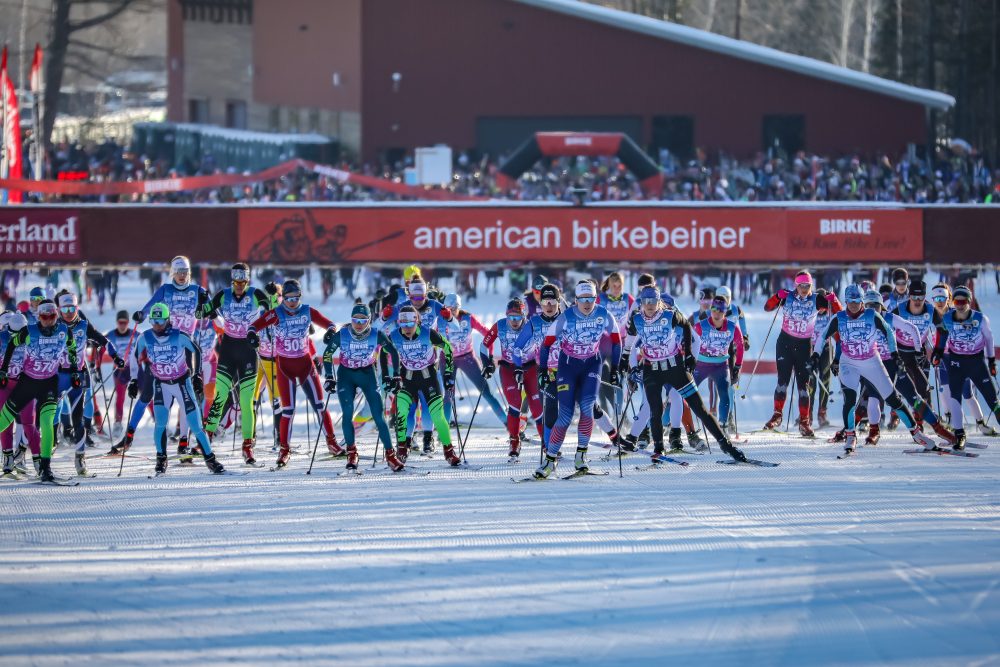
Part one of this series covered regional racing in Alaska and parts of the Lower 48. It surveyed multiple sources suggesting that the true health risk involved with ski racing is not what happens on the race course, perhaps especially in an interval-start competition, but rather what happens outside of it, in the process of traveling to the race, or eating or drinking or sleeping while doing so, or returning to a home community after traveling to somewhere else.
With this in mind, there is an elephant in the room, and it’s wearing birchleggings: the American Birkebeiner. The Birkie, which is scheduled to start on Wednesday, is perennially the largest ski race in the country, a multi-generation celebration of skiing that brings over 10,000 athletes and tens of thousands of spectators to rural Wisconsin. Only a tiny fraction of them live in the immediate area; in 2016, the last year for which detailed zipcode data is readily available, only 122 finishers in the longest skate and classic races came from the 54821 and 54843 zipcodes that include Cable, Hayward, and the surrounding areas. (Possibly relevant: the year-round population of Cable is roughly 825, and of Hayward, 2,300.)
The Birkie Trail itself is a delight to ski, and there is high-level competition at the front of the pack… but for many, many attendees, the point to the weekend, at least as much as skiing, is to see friends, to mingle in restaurants, to drink comically large beers, to eat brats on Main Street, and so on. These ancillary activities are a heck of a lot of fun. They are also, largely, contraindicated during the time of Covid; a “normal” Birkie experience feels discomfitingly like it has the potential to be the athletic version of the Sturgis motorcycle rally or the Boston biotech conference, in which people travel from a wide area, mingle with abandon, then return to their home states, in some cases bringing asymptomatic Covid cases with them.
Hindsight is, famously, 20/20, but that infamous Biogen conference at the Boston Marriott a year ago this week is estimated to have been responsible for over 300,000 cases in this country alone. The biotech conference had 175 attendees total, which is orders of magnitude fewer than the tens of thousands that typically travel to Birkieland.
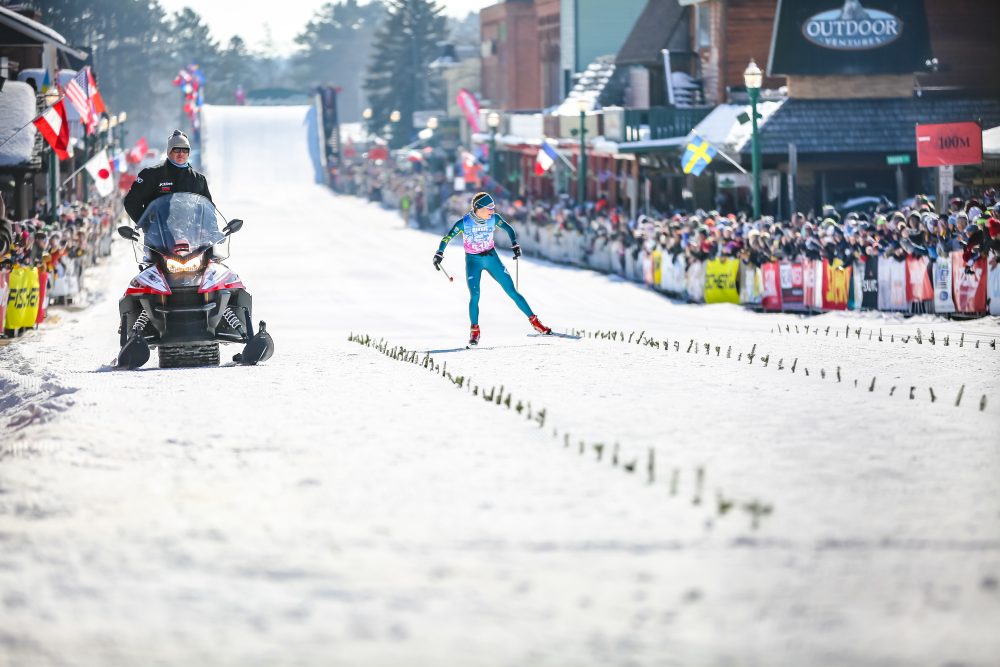
So with all this in mind, is the Birkie going to happen this year? (Yes, assuming that nothing major changes between now and race day(s) regarding either trail conditions or public health.) What’s it going to look like? (A series of one-day 43-kilometer events, starting and finishing in Cable (read: no shuttle buses), spread out over five days, with virtual participation strongly encouraged and no inside spaces available.) Should it happen? Good question.
Here’s the argument against its happening, or at least against some aspects of its happening, from current Boston resident, 15-time Birkie finisher, and self-described “huge Birkie fanboy” Ari Ofsevit in an email to FasterSkier: “I think the Birkie is doing a good job of spreading things out, but the worry would be people in restaurants and bars and doing things they really shouldn’t do (being in a hotel room doesn’t seem like an issue, being in a restaurant does). If everyone drove to Cable, skied the race, and drove home (or to a hotel room, and got takeout, and went home the next day) that would be one thing. I can see the worry that people are going to be congregating outside the race area, although even if the Birkie went full cancel, people would probably still show up and ski together and otherwise spend time together.”
On his popular site BirkieGuide.com, Ofsevit, in a recent blog post, summarizes an update from the Birkie that sounds similar notes: “There are a lot of visitors coming, but not a lot of medical capacity. Follow all safety protocols: ski on the right day, get a negative test [organizers are recommending that participants receive a negative Covid test within five days of their race day], stay in your bubble, self-sufficiency, and avoid indoor spaces (get takeout!).”
In a conclusion that ably approximates a Covid-safe version of the traditional Main Street post-race gestalt, Ofsevit writes, “Post-race: Get in your car and drive home. If you’re hungry, get takeout. Buy some brats and Leinies and New Glarus and throw the beer in the fridge while you cook the brats up at home.” (Ofsevit would also appreciate it if you record some audio about your virtual experience and send it to him for his podcast: info (at) birkieguide.com. Full recording instructions here.)
Birkie representatives are not blind to these concerns. As Birkie Medical Director Dr. Dayle Quigley stated in a November video, “Realize, however, that the Birkie organization can control the safety of participants at the start and the finish. They cannot control what happens on the trail in terms of bunching of athletes, nor can they control the hotels, bars, restaurants, grocery stores, or hospital, where Covid exposure could occur.” After discussing other safety considerations and reduced levels of on-course medical support for this year’s race, Quigley concluded, “My recommendation is that all skiers seriously look at virtual options. It will make the 2022 Birkie Week that much sweeter.”
For athletes who are nonetheless traveling to northwestern Wisconsin to ski in person, the race “strongly encourage[s] skiers to get a Covid-19 test, receiving a negative result, before traveling” to the area. Skiers are also “asked to voluntarily self-quarantine for 7 days before they travel.” Finally, skiers are also “encourage[d]” to abide by the USSS no-fluoros policy (learn how to clean your skis here).

What will they find in Cable? Less than normal. As Birkie Executive Director Ben Popp told FasterSkier in a January phone interview, “And this year, there is no party. There aren’t any spectators, you’re not finishing on Main Street. So do what’s right for you and your Birkie. So that … you don’t compromise yourself.” Popp similarly noted the large numbers of people choosing a virtual option, suggesting, “there isn’t a one size fits all Birkie this year.” And he stated that the area had already been seeing such high skier numbers this winter, he wasn’t sure if formal Birkie activities would significantly increase the number of skiers on site.
Some locals are less sanguine. A press release from the Sawyer County Health Department in late January (this year’s Birkie starts and ends in adjoining Bayfield County, but “many of the participants and guests also are expected to be in Sawyer County [the Hawyard end of the course] visiting local stores, hotels, restaurants and bars”) noted that it was “fielding an increasing number of calls from local residents who are concerned about the potential negative impacts of hosting a large international event in our rural county during a global pandemic.”
Sawyer County Public Health Officer Julia Lyons wrote, essentially, that she saw the potential issue, but that her hands were tied: “We share many of those concerns; however, in Wisconsin, both local and state health officials have limited power to maintain and enforce public health orders.” She recommended that local residents not directly involved with the event “Limit your travel to public spaces and continue to follow recommended safety guidelines,” such as “Stay home as much as possible” and “Wear a mask in public spaces.”
Some locals did not appreciate being urged to stay home while thousands of visitors, and their tourism dollars, were welcomed into the area. The health department’s Facebook page features a robust discussion of this topic. One commenter noted, “If 5000 participants plus their spectators and volunteers from all over the world can be at an outdoor event I would imagine Julia Lyons would be fine with children in our community playing together on a playground without worrying about mixing with other classes. The hypocrisy is beyond ridiculous. She recommends this and that but when it comes to the BIRKIE has no recommendation? Ben POPPE [sic] is a hypocrite serving on the COVID panel…. he had one agenda. How do you expect the community to respect any of your recommendations when you aren’t consistent.”
Another observed, “I do find it ironic that schools can’t operate normally, restaurants can’t operate normally, stores have restrictions — but the birkie can go on as normal! $$$? Money for the town/county, not for the safety of the residents.”
(The money involved is significant. In 2017, Wisconsin’s governor, in declaring Birkie Week in late February, noted that the Birkie brings in 26 million dollars annually. “That’s nearly $1,000 per person for Sawyer and Bayfield counties!,” Ofsevit wrote.)
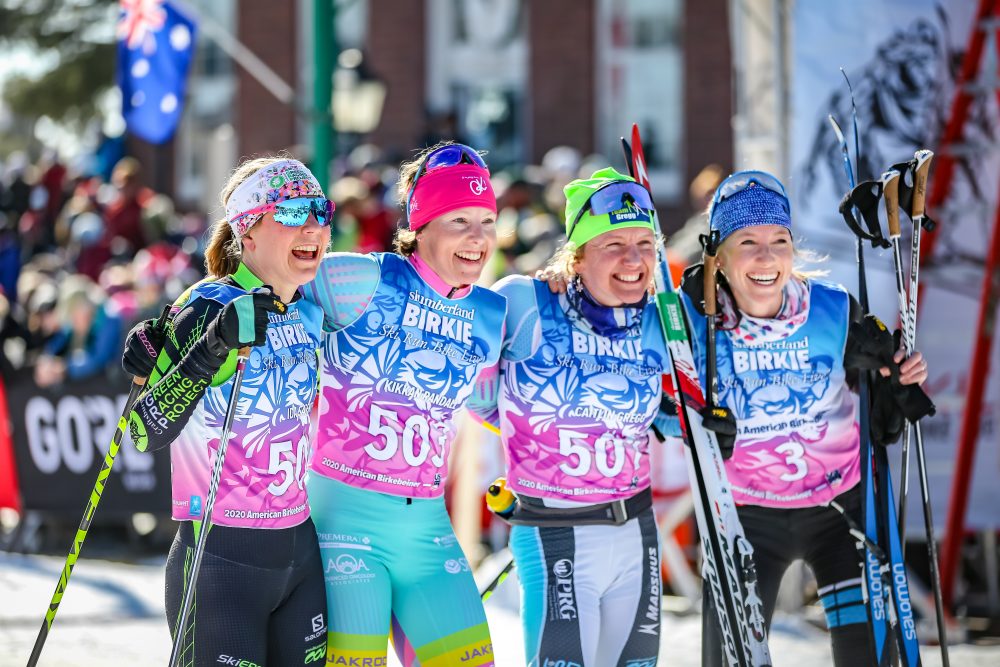
Similar comments have followed on subsequent posts from the agency. Wisconsin Public Radio recently published a thoughtful piece surveying these concerns, with comments on both sides of the issue from local hospitals and business owners as well as from Popp.
As of February 21, Covid case numbers in Sawyer County were at a seven-day average of 26.7 cases per 100,000, over twice the Wisconsin statewide average of 12.7.
FasterSkier spoke with Popp in late January about some of these issues. (The interview occurred four days before the issuance of the public health statement quoted from above, and so did not ask about the health department’s statement specifically.) The interview transcript follows below. Popp’s comments have been lightly excerpted, with elisions noted, for brevity and clarity. This reporter’s questions have been more heavily edited, to make the overall piece more readable and to provide better introductions to Popp’s answers.
FasterSkier: I’m writing about ski racing in the Covid era, and I’m looking at what different races are doing in different parts of the country. My working assumption by this point is that whatever happens on the course is, if not no-risk, at least low-risk – I’ve read the Birkie website, the discussion about buffs on at the aid stations and at the finish, smallish waves of racers starting throughout the day, five different days of racing, and so on. So let’s assume that there’s a low risk of health issues on-course. That said, it’s no secret that a lot of the appeal of the Birkie is what happens afterwards – I did it once, and yes the trail is great, but all my best memories are honestly about the awesome people I met in the bar before and after the race, and how much fun it was to be in a small town with 10,000 other skiers for a few days. So with all this in mind, assume that you’re keeping people pretty safe on the course, which I think is fair. Do you have concerns about everything that happens before and after those two or three or five hours of skiing?
Popp: I think if it was a normal year, I would say of course, you know, I think if we thought that Birkie 2021 on the ground was going to be like a normal Birkie, that then, of course, I think we’d have huge concerns. I think as we see it evolving now, we feel better and better about what’s not only happening locally and regionally, but sort of what we’re seeing happening on the ground.
And maybe to take a step back. I think we’re now – by going out and creating virtual options, we’re seeing a huge shift in people choosing virtual, because we’ve really started to message that, hey, there isn’t a one size fits all Birkie this year. What we’re seeing, I think – one of the largest percentage of people that are coming are people that are either going to make a day trip of it, or that they own a place here, and that they come here routinely. Or people that are here frequently.
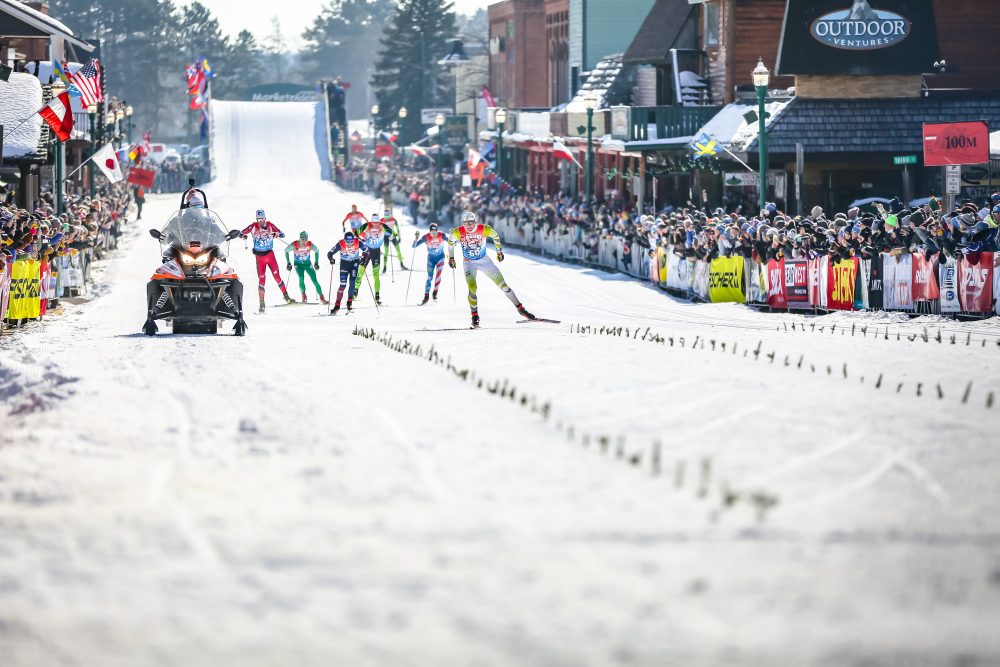
In fact, we’re seeing literally record numbers of skiers and pass sales this year, out on the trails, and it’s the people that are coming up as training for the Birkie. And so I think the people that we’re going to see on the ground, or we know the people that we’re going to see on the ground based on just who we’re seeing switching to virtual, are the people that can travel there easily, or they’ve already been. Because again, right, if it is really going to be difficult to travel. The same reason there aren’t SuperTours all over the country is that – last weekend, for instance, we had a JNQ, we had 935 people through the venue – that was over 400 racers, and then parents, spectators, and coaches. We only know that because everybody had to check in after they did their e-screening. They do their Covid e-screening, and then checking in to get a wristband and get their face mask if they didn’t have one.
And so that part of it, and that was coming from a very similar, right, range of Michigan, Wisconsin, Minnesota, these people could easily make it. And so what we’re seeing is I think that again, in a normal year, yes, that would be like, Oh my god, we’re bringing all these people here. But first and foremost, we’re seeing that number coming down pretty significantly because of these virtual opportunities. And then the other thing is that and I think well, I shouldn’t say – this is not unique to here, but I think maybe unique to ski destinations.
Oftentimes ski destinations are very much tourist locations, right? People want to go there to do the fun things that they do. And so we are no different than that. People love to come snowmobile, cross country ski, icefish, do all the things you do in northern Wisconsin. And we’re seeing really record numbers of visitors coming to visit here right now. And so what that tells me as a community – even though we can only control what we can do on the ground in a ski race, our other community partners – restaurants, grocery stores, housing establishments – they’re all putting in similar protocols. Because right, they’ve been operating through this whole thing as well.
And now we’re seeing actually record low [Covid] numbers happening since our peak back in September. In the area, even as we’re seeing tourism really booming right now, because everyone wants to get out of the metropolitan areas and go snowmobiling or skiing and biking. So I think what we’re seeing, and the reason that we have confidence that the community will be safe, is that I get as I call our, quote unquote, community partners, like I said, whether it’s a grocery store, you know, and what the precautions are, restaurants are almost all doing takeout or pick-up, you know, the different cleaning protocols that they have to do now for housing. And I think, to your point, this year, the Birkie skiers aren’t going to be sitting at the bar for four hours drinking all night afterwards; it is going to be very different than that.
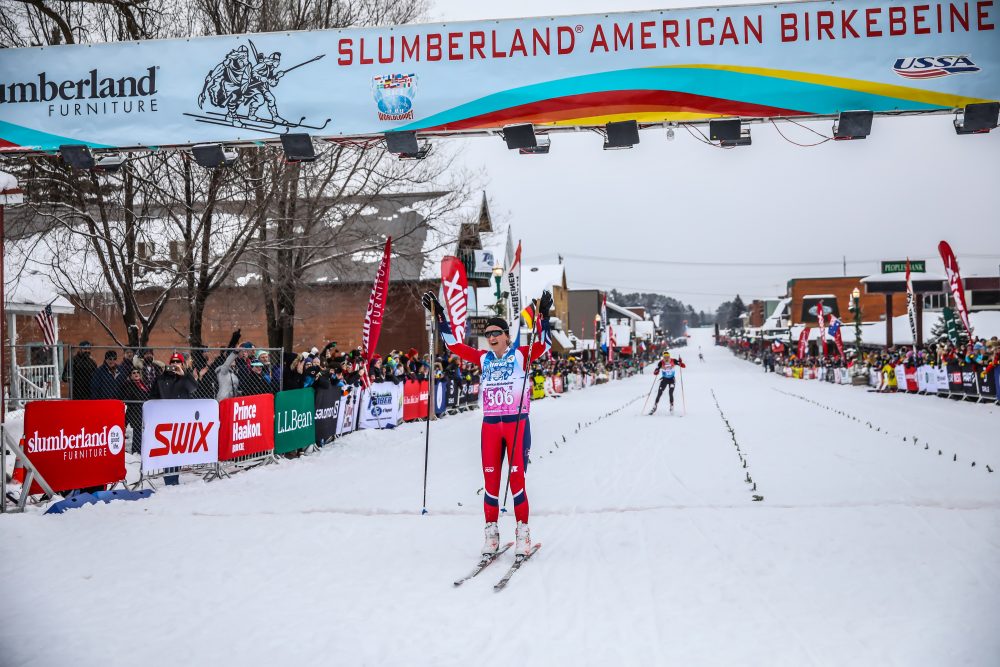
So I think all of those pieces as they come together now, are really part of it. And then the other part that we’re doing is that all of our staff, all of our race chiefs … they’ll be all masked with N95s. And, you know, we also likely will test all the staff beforehand, because they’re the ones interfacing obviously, with most people.
But, you know, when we were talking to one of the epidemiologists that we work without in the Twin Cities, talking about their protocols and taking a physician back to work after COVID, is they’re using an N95; they wear it all day, they don’t touch it, or take it off. That’s the level of safety an N95 brings, that having the staff and the volunteers that are interfacing with any of the skiers outside because we have no inside spaces being protected with an N95 felt like that’s going to even further enhance some of that. And so I think putting all those things together, we actually feel pretty good about it.
In terms of general numbers, do you currently have a sense as to how many people we’re talking about showing up in person?
My best guess at five weeks out [as of a late-January interview] is that we’re gonna have around 4,000 skiers total, that’s my best guess right now. … That’s looking at the current trend line of people going from in-person to virtual.
So that sounds like roughly 800 people per day over five days?
Yeah. And it’s, of course, not perfectly equal. More people want to show up on Saturday [the traditional race day, and the day that this year’s Birkie skate champions will be determined], so Saturday is gonna be like, probably, 1100ish. But again, that is, I guess, a little to be determined. But yeah, that’ll be the biggest day. And then I think our smallest day right now is around 500, which I think is Sunday. And those of course are switching a little bit or kind of shuffling a little bit, but not for the most part. Pretty, pretty close.
The Birkie media folks told me about the other events you’ve hosted, and cited your successes there. Roughly how many people are we talking about in those races?
So the Birkie Trail Run was around 1000. The Ascent was 250. Seeley Hills, Birkie Tour is going to be around 850 to 1000, we’ll see this weekend obviously. Gitchi Gami Games, with skiers or spectators, was 935 one day, and like 897 the other. And that was a little heavier on numbers, simply because obviously, when you have a youth event, you also have – you know, my kid’s 14 and can’t drive to the race, obviously. So you end up with – versus the Birkie, when we’re not allowing any spectators, then suddenly, you know, well, I’m just driving up, I’m going, racing, then coming home, so it’ll be – it’s a different dynamic of people, I think, obviously, for Gitchi Gami versus obviously more of an adult race, like the Birkie.
I know you have a sign-in app, and some degree of contact tracing potential, or at least knowing who was there. Can you tell me if you have had positive cases coming out of those events?
Knock on wood – no, we have not had any reported – anyone either report back to us or say that they had Covid. Again, somebody could not tell us, obviously, and we would never know, but we’ve not had anybody report back.
So just to clarify, you had all those events, and you have not had a single person affirmatively get back to you about a positive Covid test.
Correct. … But no, knock on wood. We’ve been very fortunate. We’ve not had any – no one’s reported any cases from the event or that they had it while they were at the event.
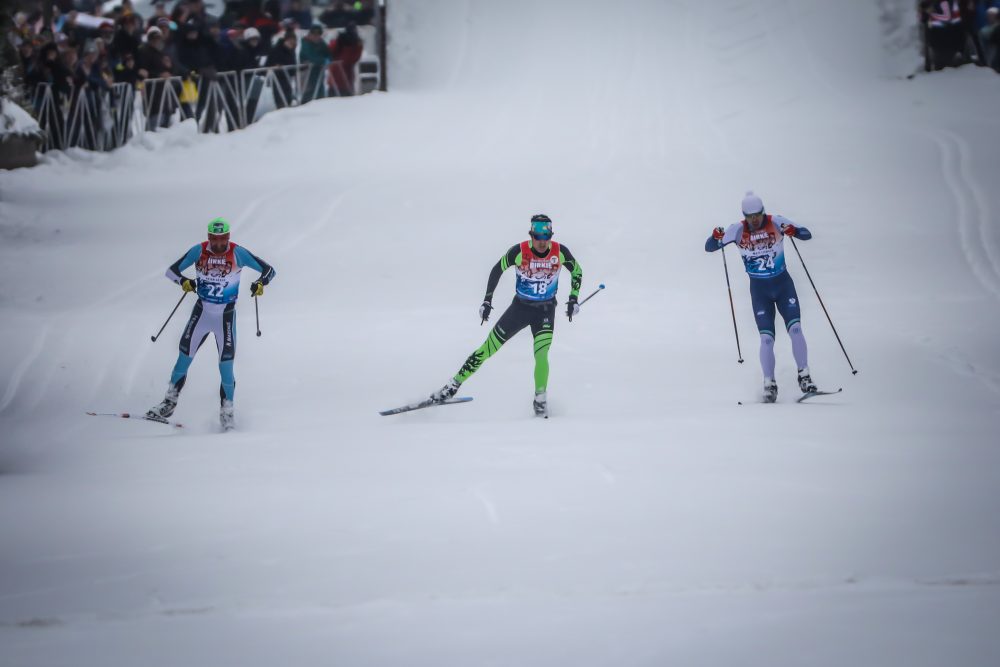
Again, as I’ve said, I’ve been looking at what the risk factors are. And from what I’ve seen, the on-course stuff really doesn’t seem to me to be the problem. Is that fair?
Yeah, I agree. And I think the other thing is now in all honesty, and it’s the reason other races are now opening up and starting to happen all over more and more, is that we understand the virus better, and we understand how it’s transmitted.
You know, initially, we weren’t sure of anything, right, my wife’s a physician, and every night was like, holy [cow], what is going on, what are we going to do? Now, as we learn more about the safety protocols and can further protect ourselves, even as a traveler or somebody that’s going somewhere. And all that, okay, I just got to carry my hand sanitizer, and I always got to be masked and those simple things, and keep my six feet. Boy, by doing those couple things, I am actually really, really, really very unlikely to get it. And gosh, I go to a place and I need to get food. Well, I’ll get takeout or curbside pickup or, you know, I’m gonna get a condo that’s a kitchen so I can make all my food indoors. And so I think what we’re finding is, as skiers, participants, just general travelers, we’re getting better at implementing safe protocols around how we travel or move around.
It was really interesting at Gitchi Gami Games, my job was one of the really fun ones to walk around, tell people to put their mask on. I think it was probably over the two days, less than a half a dozen times I had to ask somebody to do it. And then it was always like a, Oh jeez, yeah, sorry, type of thing. It wasn’t really, [makes angry noise] grrr. I think I was talking to some people afterwards, and I said, “Man, I don’t get it. People, you know, gosh, in the general population, we don’t see that kind of compliance.” And you know, somebody said, “Well, it’s because I think everyone really wants it to work.” And everybody, these families all want to go ski racing, they see how happy their kids are. … And so they really want to make it work. So they’re willing, and want to follow the rules, because they know how important it is as part of their lifestyle or whatever, which was really fascinating. I hadn’t really thought about that before.
And so I think that will carry over to the general, the greater Birkie crowd and the greater ski crowd, and that people want to do the things that they feel like are going to protect them and others because they value it, they want it to keep working and make sure that it does, because it makes them happy. And it makes them feel good. And so, I don’t know, maybe that’s just wishful thinking, or just we were making that up or something. But … I was like, wow, that resonated with me.
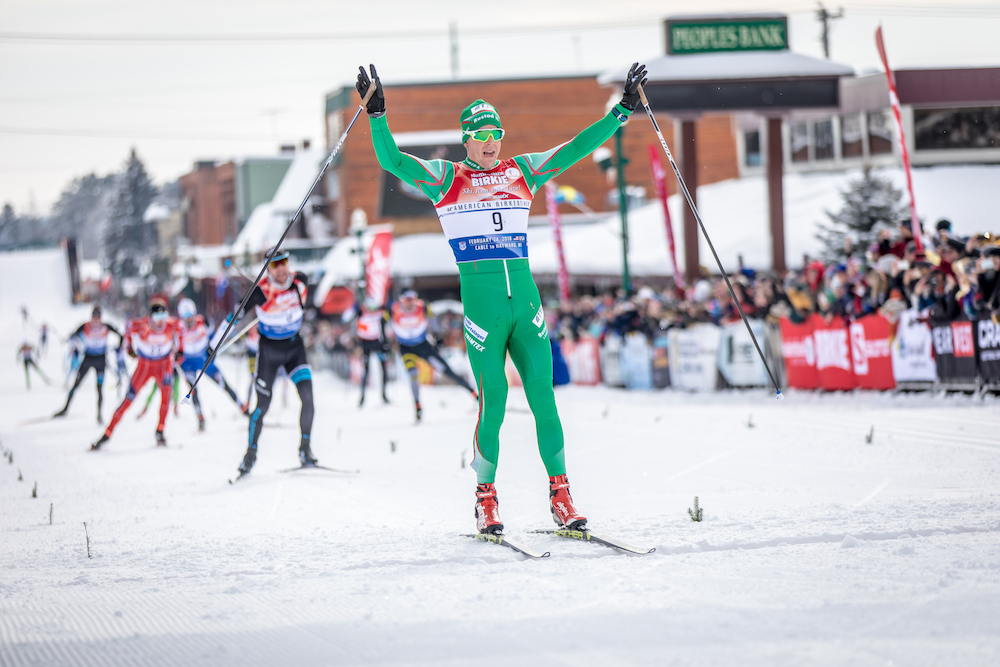
So in terms of the local community that you’re in, clearly plenty of people travel for this. They travel from the Twin Cities, mostly, and other parts of Minnesota, Wisconsin, and Michigan; I traveled from Anchorage; in the typical year, tons of people travel. It’s sort of this magical Birkieland where there’s awesome grooming and very large beers. But in all seriousness, there are, as you know well, real people who live in Cable and Hayward year-round.
So my simple question about this is, are there currently public health orders that bar this event? It looks like if the race were being held the first weekend of January, it wouldn’t have been allowed under a Bayfield County public health order that was then in place. It’s after January 3, so that’s not relevant… but still, the simple question is, are there state- or county-level public health orders that bear on this? And the larger question is, how would you characterize local community views toward hosting this race, even in a five-day format? On the one hand, if you run a business in the area, you presumably have an incentive to have 4,000 people come through. On the other hand, I’m sure the local hospital is tiny. How would you characterize these views?
No, there aren’t any currently health orders barring it, because if there was, and we wouldn’t do it – couldn’t do it. Obviously Kristy Maki, our event director, works really closely with Bayfield County, Sawyer County health departments, as well as our local health provider, Hayward Hospital, and they meet, I think it’s every other week, looking at trends, looking at what can we provide, what can’t they provide, what are their thoughts?
And so yeah, I would say that we work very, very closely with the health departments and following their guidelines; they have helped us put in place some of these different ideas and modifications. So yeah, I would say at this point, they’re certainly supportive of what we’re doing. Because if they’re not, we wouldn’t be doing it. And what we’ve all said all along is things can change in a day – if a week from now, things suddenly skyrocket – you know, something happens or changes immediately, we often have said, Hey, we’ll absolutely on a dime switch, if that’s what has to happen, and say, you know what, things are skyrocketing, or this happened, we have to go completely virtual. We completely want to be transparent that if the health officials that we’re working with say that’s got to be the case, that will absolutely be the case.
And I think when you talk about local residents, I think you’re exactly right. It’s is no different than any other topic of debate these days. You know, some are like, There’s a lot of skiers, and a lot of business owners that are like, Absolutely, this is safe. One, to your point, there’s record numbers of people already coming to the area to recreate and ski; as I mentioned, our trail pass sales are up like 50 percent, over 50 percent in some instances, 100 percent month over month. And so, like we know, there’s already huge amounts of people coming here. So, arguably, by doing the Birkie weekend, I don’t know if there’s really going to be that many more people here. And so from the skier perspective and the businesses that are already seeing those people that are like, Well, why wouldn’t we, we’re already seeing those numbers of people here anyways.
On the flip side, I think there’s other community members that are more like the line of thinking of what you’ve said early on, what I think of is when I think of the Birkie, there’s going to be 40,000 people, bars packed, crammed in downtown, busy tents, stuck on buses, and then that is going to be a health disaster. And so I think there are definitely both perspectives and/or opinions on it within the community.
And, you know, like I said, we’re doing what we think is best – I mean, all of us live in this community. It’s not like we all live in the Twin Cities and commute here every morning – our kids, our kids go to school here, we go to the same churches, all those sorts of things. So we’re definitely ingrained within the community and want to do what’s right for the community. We’re not going to do something that is going to bring a superspreading event to the area.
So I would say that, yeah, the experts on that are our health officials, right. That’s why we don’t make that call; we rely on the health officials that are dealing with public health. Certainly one of the issues with the hospitals early on was they had people that were having to be quarantined, and so they were just working like dogs. However, as they get, you know, they’ve now all been vaccinated and are able to be back to work. So the healthcare force is regaining a fair amount of strength.
And so we have that dialogue with them and say, We’ll own the decision. Of course, the decision has to be ours. Absolutely. But we’re going to take your guidance, you’re the experts in the world of public health, and our local health care system. You tell us what you think. And that’s going to help us frame up and determine what’s right and what’s wrong, or what we can and can’t do.
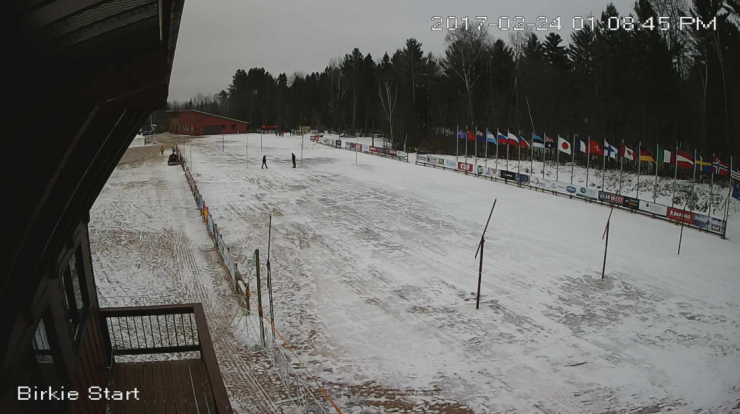
I’m put in mind here of the run-up to the 2017 Birkie, which I’m sure you remember very well. Many people were struck by your openness and transparency while they were trying to decide if they should cancel plane tickets or make other plans. What did you learn from that experience that you’re bringing to bear on this year’s race?
We went, hopefully from the start this year of continuing to say, Hey, listen, things could change, I mean, not necessarily maybe overnight, but certainly over a matter of 10 days, you know, if there’s something that happens, and all of a sudden cases start to go on the rise hugely, or whatever. …
One of the reasons that we’re also, I think, very cognizant of keeping people updated is that, listen, whether you want to do your virtual Birkie in Madison, or Milwaukee, or Boston, or Steamboat Springs, or Royal Gorge, wherever you want, if that’s the right thing for you, you should do it, because you’re still gonna get credit for the Birkie. You know, a lot of people are like, Oh, I want to get credit, you know, I gotta get my 11th. … The message now is like, Listen, if it’s just about you coming to get credit, then do it wherever you want. There’s no difference.
And this year, there is no party. There aren’t any spectators, you’re not finishing on Main Street. So do what’s right for you and your Birkie. So that it – so that you don’t compromise yourself and put yourself in a place it. At the end of the day, if you come up, and we can’t do the Birkie, it’s all virtual? Well, you can ski it anywhere you want, you can still ski it if you’re here. That’s irrelevant. That is, you know, one of the reasons that, you know, frankly, like I mentioned, there’s already been nearly, I think, as many people here that we normally will have even at Birkie weekend, interestingly enough, just because the numbers are coming down by people choosing virtual and wanting to – obviously we’re not getting any Europeans, my guess is the elite field will be very, very, very small, probably a regional, right, Brian Gregg and Caitlin, etc., right? …
And so, you know, it’s the people that can be here that are in the area, you’re not going to, you know, fly across the country just to come , you know. In fact, the prize money has also been reduced greatly for that very reason. … One of the things we really want to do is disincentivize that you’re only coming to win money. [Popp then explained that the overall prize money has been substantially reduced. This year’s prize money amounts may be found here on page 14.]
So I think that as a group, I mean, I hate to overgeneralize, but the ski community is a generally smart group of people that often really use good judgment. Now, maybe not on the starting line, you know, but in general, I mean, really does use good judgment. And I think, this year, you know, sort of this mantra, that it’s not a one size fits all Birkie, is something that we continue to really push. … Because again, it’s easy if I live in Minneapolis or Madison to make a day trip. No problem driving four hours. Come home. But on the flip side, it’s very different if I’m trying to get here from Tampa, Florida.
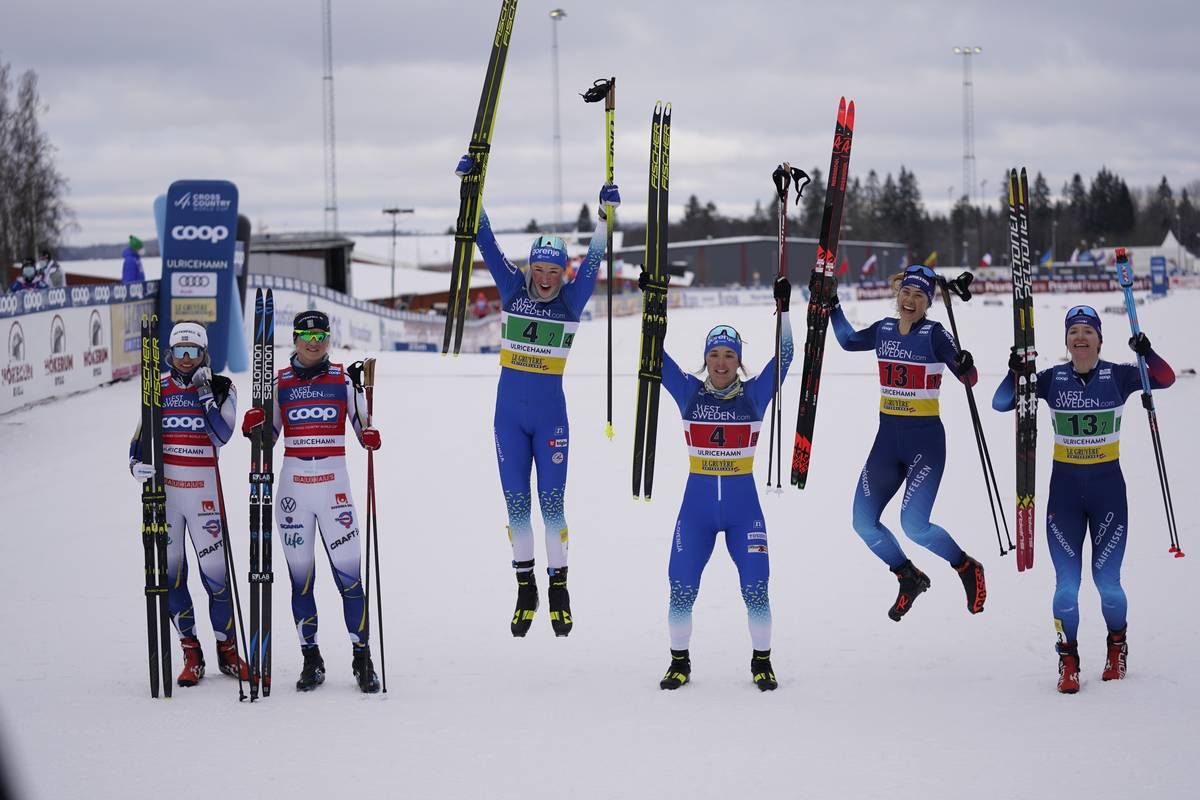
One last question and this one’s actually from Jason Albert: On the World Cup, we’ve seen mixed fidelity to post-race mask wearing in the finish zone. Will the Birkie be more forthright in enforcing mask-wearing post-race?
Absolutely. Yeah, period. That’s a great question. And something that we’ve worked really hard on at the finish line, and actually the start line. So we tell you, you got to take your mask with you, because you’re gonna need it at the end, and show us how you’re going to take it with you, you know, don’t have a paper mask around your chin that you’re going to throw, because then you’re not going to have it at the finish.
And we will, I mean, we will have them at the finish. I’d rather not buy 10,000 masks, or 4,000 masks, we will have them at the finish for those that don’t. We’re not going to let them leave the little tunnel area – we built a separate stadium that they’re going to be finishing in. And so they have to walk out under a tunnel to get out of it. And we’re not going to let them leave out of that area, once they finish, where they kind of go back to get to their car and stuff, without it.
And so we’re going to be very diligent on the post-race. Because we’ve seen it now with the juniors, originally, we were like, We’re going to be really hard at the end. Well, it was too late. Because they got there, and they had nothing. So we’ve kind of learned now that you got to be really hard at the start. Show me how you’re going to be carrying this thing – like, is it a buff? What is it? What are you going to do with your mask, because the other thing is we’re going to require you to put it on in the aid station. So if you’re planning to stop at an aid station, you’re going to have to put it on, otherwise, sorry buster, there’s no stopping. And this year is very much self-serve anyways in the aid station. But if you want something, that requires a mask, so you gotta show us how you’re going to carry that with you. In other words, is it around your neck? Is it going to be – what, you tell us. And so I think that’s what the takeaway from us has been, be diligent at the start to ensure they have it with them at the finish. That’s been maybe our best – a little offense has been the best defense, if you will.
* * *
In-person events for this year’s American Birkebeiner start on Wednesday morning. The 2021 Birkie and Kortelopet skate champions will be crowned on Saturday, and 2021 classic champions on Sunday. Other than prize money for the top six finishers in the skate Birkie, and top three classic finishers in the classic Birkie, this year’s results will not be used for age group awards this year or for wave qualification or placement next year.
Gavin Kentch
Gavin Kentch wrote for FasterSkier from 2016–2022. He has a cat named Marit.



